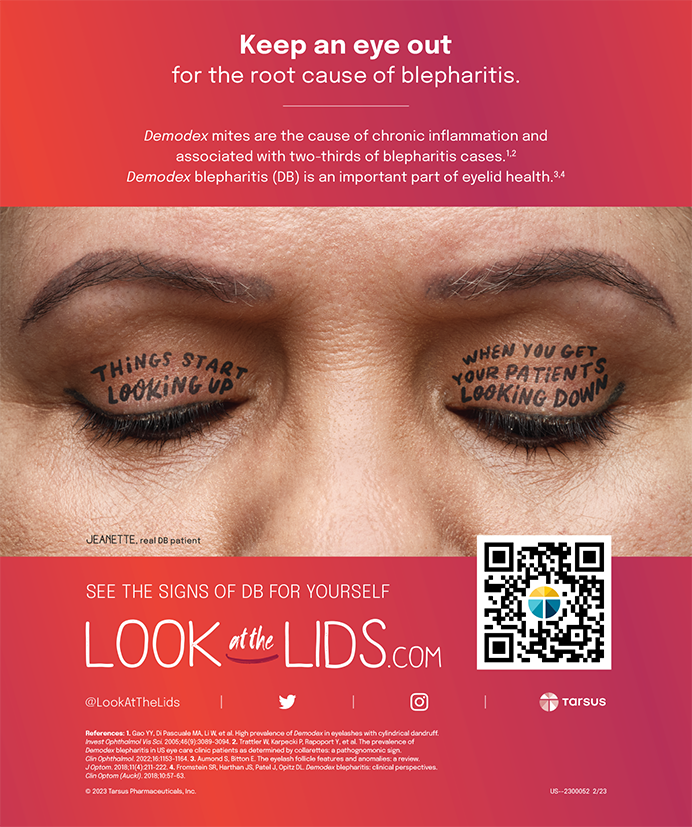Transepithelial topography-guided PRK for keratoconus is a difficult topic. Because we ophthalmologists do not know if all patients' conditions will progress, operating on them may or may not hasten the pathology's development. My colleagues and I decided to study the usefulness of this procedure in a group of patients with keratoconus who were awaiting corneal transplants. My partner, Simon Holland, MD, is a transplant surgeon and has a list of patients who have a year's wait for a corneal transplant. Patients who are contact lens intolerant and have anisometropia are challenging to help. We decided to investigate transepithelial topography-guided PRK with the Allegretto Eye-Q 400-Hz excimer laser (WaveLight, Inc., Sterling, VA) as a possible treatment option for some of these patients.
METHODS
In our study, Dr. Holland and I enrolled 16 keratoconic, contact-lens–intolerant patients, all of whom were waiting for a corneal transplant. They had a BSCVA of 20/20 or better and a residual stromal thickness of greater than 300 ?m. Our goal was to maintain a minimum corneal thickness of 350 ?m after transepithelial topography-guided PRK. All patients in the study signed an informed consent that detailed the possibility of a future corneal transplant.
We performed transepithelial topography-guided PRK with the Eye-Q laser, which reproducibly removes the corneal epithelium in approximately 15 to 20 seconds. We used my topographic-neutralizing technique (discussed later). Following the corneal ablation, we applied mitomycin C 0.02 to the patients' eyes for 15 seconds and placed a bandage contact lens. Patients instilled a standard steroid-tapering drop (FML Ophthalmic Solution; Allergan, Inc., Irvine, CA) for 3 months postoperatively. Follow-up lasted 12 months.
It is important to note that transepithelial topography-guided PRK is not a refractive procedure. Rather, the treatment addresses corneal irregularities and thus induces a refractive change. The surgery is based on refraction, not keratometry alone. Transepithelial topography-guided PRK is therefore a potentially two-staged procedure consisting of topographic smoothing and refractive adjustment.
THE PROCEDURE
Surgical planning for transepithelial topography-guided PRK involves four steps. The first step is to analyze the plano treatment for smoothing the cornea. The plano treatment is produced by the Allegro Topolyzer (WaveLight, Inc.) when no refractive input is entered; in a keratoconic eye, it is essentially a mini-asymmetric hyperopic treatment. Second, the surgeon identifies the cylinder induced by the plano application and the amount of astigmatic treatment needed for neutralizing the cylinder. The third step involves adding a myopic treatment in the center of the cornea to compensate for the initial hyperopic ablation. In the last step, the surgeon adds the manifest refraction to calculate the final treatment (Figure 1).
Dr. Holland and I initially experienced a problem with this treatment, because we did not understand how the plano zero topolyzer treatment induces astigmatism by smoothing out the cone. If this astigmatic effect correlates with the patients' astigmatism, then it works well without reversing the astigmatism, if we do not add this correction in the final step of the planning process. The astigmatic correction is already accomplished by the plano zero treatment. If we add the astigmatism to an already neutralized cornea from the zero treatment, we overcompensate and induce against-the-rule astigmatism.
Once we identified this problem, we tried to choose patients who had astigmatism that correlated with our neutralizing technique.
EXTREME CASE OF KERATOCONUS
We treated one patient with a preoperative corneal thickness of 385 ?m and high astigmatism. After undergoing transepithelial topography-based PRK, he achieved 20/40 vision UCVA. We treated less than half of his astigmatism, because the neutralizing technique worked well. His BCVA was 20/20 postoperatively (Figure 2).
Why does this procedure work so well on thin corneas? The goal is to make the flat area of the cornea steeper and to flatten the steep area. Most of the treatment occurs in the thick peripheral cornea. In biomechanical terms, the cornea must become more even in its distribution of forces. I think that is why this patient, although he has a residual cornea of 375 ?m, has achieved good results postoperatively.
Two years after surgery, the patient's topography has remained largely unchanged (Figure 3). There is essentially no change between the 6-month and 2-year topographies. Subtraction topography shows progressive ectasia with relative steepening in the thinned area, which does not appear in Figure 3.
OVERALL RESULTS
In our study, 100 of the patients achieved a BSCVA of 20/40 or better. Most either gained lines of visual acuity or experienced no change. Only 12 of patients lost one line, and none lost two or more lines. All subjects achieved a reduction in their astigmatism from 5.00 to 1.00 D. No one experienced an increase in astigmatism. Most patients (88) did not develop haze postoperatively.
CONCLUSIONS
For patients awaiting corneal transplants who are intolerant of contact lenses, transepithelial topography-based PRK may work well in selected cases. Applying the treatment away from the keratoconic cone and weakening the thickest part of the cornea may stabilize the eye biomechanically. The refractive algorithms have to be adjusted using this topographic neutralizing technique. The topographic cylinder does not necessarily correlate with the refracted cylinder, and the topographic neutralizing technique shows that we generally treat the topographic cylinder as opposed to the refraction. As for any surgery, physicians attempting this procedure must counsel patients in order to set realistic expectations.
PRK is ineffective for cases of severe keratoconus. Long-term follow-up of transepithelial topography-based PRK is warranted. Posterior curvature analysis with the Oculyzer (WaveLight Inc.) is necessary.
David T. C. Lin, MD, FRCSC, is Clinical Assistant Professor of Ophthalmology at the University of British Columbia and is Medical Director of the Pacific Laser Eye Centre in Vancouver, British Columbia, Canada. He has received travel reimbursement from WaveLight, Inc. Dr. Lin may be reached at (604) 736-2625; tclin@shaw.ca


